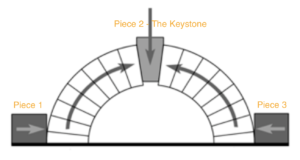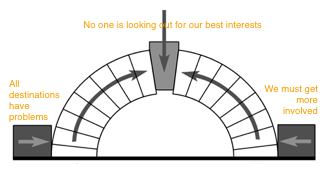In both business and personal spheres, I’ve noticed that the most successful people seem to be the ones who can get those with opposing or unrealistic viewpoints to adopt new understandings and grow.
The more I observe these kinds of influencers, I sense that their communication skills tend to follow a common pattern — walking clients/colleagues/friends from a ground of mutual agreement (starting point) to a newfound place of advancement (end point) with little resistance, using tiny steps or links in what I call a Logic Chain: a chronological and inarguable sequence of affirmations that moves people to a better place.
The way I like to describe the logic chain is in two sides of a river. The Logic Chain avoids making people think they have to take a big leap to the other side (because that is overwhelming and stressful). Instead, the Logic Chain uses a sequence of small steps that form a bridge which leads people to the other side comfortably. In the Logic Chain, order is everything: you could have all the right pieces to make the bridge, but if they’re not strategically oriented to one another, the bridge is not sound and your recipient cannot cross.
How to create your own logic chain?
When trying to convince someone to try your product or to adopt a new outlook, consider the three main pieces of the logic chain:

Piece 1) Identify an inarguable fact or sentiment: this affirmation must be widely accepted as truth or common knowledge (or at least accepted by the recipient).
Piece 3) Identify the end goal or action: this is the message you are trying to get across.
Piece 2) Identify the “Keystone,” turning point, the pivot, revelation, adoption: the intermediary moment or action that the idea realistically catches on, bridging the gap from “what is real today” and “what is feasible tomorrow.”
Examples of Logic Chain in Action
In The Star Throwers, we set off on a mission to unite stakeholders in our industry (vacation rentals) around the concept of giving back to their local communities. Communicating the importance of community involvement for us was the big challenge, because for small business owners, giving back is typically low on the priority list. So we used a logic chain that went like this: (Piece 1) All great destinations have their share of challenges > (Piece 3) If we don’t solve our community problems, who will? > (Piece 2) Our livelihoods as small business owners are tied to these problems, but the entities that should fix them are broke. Here it is in visual form:

Have you ever had experience with a logic chain?
Has a keystone piece of the puzzle ever changed your viewpoint for the better?
As mentioned, this is a working theory so I’m excited to hear ideas.

